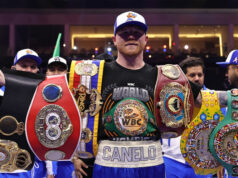When I first started judging professional boxing 13 years ago, I always thought that having a split decision was a failure on the part of the judges, whether it be me or one of my fellow officials. Over the years however, I have begun to take a slightly different view of split decisions. This comes as a result of analyzing the scores of various (and sometimes controversial) split decisions. What I will not do here is call out any specific fights or any specific judges as doing so would go against my personal code of conduct.
The point that I’m trying to make here is that not all split decisions are created equal. For example, take the following 3 scenarios using fictitious scorecards:
 My analysis of these scores would indicate the following:
My analysis of these scores would indicate the following:
- Judges #1 & 2 both agreed on the winner of the bout
- On the surface, Judge #3 being the “lone wolf” as the only judge who scored the fight for the loser would appear to be the one whose score would be most criticized
- However, I would contend that although he agreed with Judge #1 in picking the winner of the fight, the scorecard of Judge #2 is the one that should be examined more closely
- Although they chose different winners of the fight, the scorecard of Judge #1 was actually closer to the scorecard of Judge #3 than it was to Judge #2 who actually agreed with Judge #1 in terms of who won the fight
- Despite choosing different winners of the fight, Judge # 1 and Judge #3 actually agreed that the fight was very close
- The scorecard of Judge #2 would seem to indicate that he saw a fight that wasn’t that close
 The scores above represent to me the worst kind of split decision as I’ll explain below:
The scores above represent to me the worst kind of split decision as I’ll explain below:
- Clearly, all 3 judges saw the fight as a one sided affair
- Judge #1 and Judge #3 both saw Fighter A as dominating Fighter B and only disagreed in their respective scores by 1 point
- Judge #2 also saw the fight as a one sided affair
- Although by virtue of his score, he obviously saw a totally different fight than did Judge #1 and Judge #3 as he overwhelmingly scored the fight for Fighter B
- Once again, as a result of being the outlier “lone wolf” judge in the above scenario, the scorecard of Judge #2 should be heavily scrutinized
 Finally, we come to what I would call a “legit split.” What I mean by that is that some rounds are just that close. So close that although the respective scorecards of the judges may differ slightly, it is clear from the tightness of the numbers above that all 3 judges saw the same fight. It goes without saying that some scores will naturally differ because of the different views that the 3 judges have during the fight and the different perceptions of dominance in some of the close rounds. Nevertheless, I would contend that a split decision like the one portrayed above should be expected from time to time and should be expected and accepted.
Finally, we come to what I would call a “legit split.” What I mean by that is that some rounds are just that close. So close that although the respective scorecards of the judges may differ slightly, it is clear from the tightness of the numbers above that all 3 judges saw the same fight. It goes without saying that some scores will naturally differ because of the different views that the 3 judges have during the fight and the different perceptions of dominance in some of the close rounds. Nevertheless, I would contend that a split decision like the one portrayed above should be expected from time to time and should be expected and accepted.
My conclusion is that there can be both “good” and “bad” split decisions and I believe that the 3 examples portrayed above illustrate what I mean when I said at the outset that “not all split decisions are created equal.”










